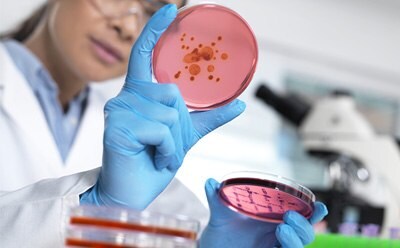Bioburden Testing

Bioburden is the presence of microorganisms on a surface (or complete item), inside a device, or from a portion of liquid, prior to sterilization. Bioburden can be introduced from the raw materials used in the manufacturing process, via the workforce or manufacturing environment. With numerous sources of potential contamination, the bioburden of a product can fluctuate between batches. Bioburden testing is a quality control process used during production to quantify microbial contamination in water, raw materials, or finished products to ensure the safety of a manufactured product. Effective quality control and accurate test results are essential to minimize risks for consumers and required by regulated production environments. Hence, bioburden analysis is often included in routine testing performed by manufacturers to ensure the safety, quality and regulatory compliance of each product batch.
Bioburden testing is performed for medical devices, pharmaceuticals, packaging, raw materials, human tissue, animal tissue, and cosmetics. While following any of the standard methods described below, it is important to ensure that the testing method does not either introduce bacteria into the test sample or kill bacteria in the test sample.
Related Technical Articles
- Microbial membrane filtration with the Milliflex Oasis® vacuum pump and filtration funnels for bioburden and water testing.
- Detect microbial contamination faster with the Milliflex® Quantum system. Using fluorescence-based technology, this non-destructive method can help microbiological enumeration before the colonies become visible
- Comparison of convenience, operating time, accuracy, costs and safety aspects of single-use funnels vs. reusable funnels for the membrane filtration method in QC microbiology.
- Easy-to-use vacuum filtration manifold for bioburden testing eliminates sources of contamination.
- S-Pak® membrane filters for microbial bioburden testing
- See All
Related Protocols
- Routine water and beverage microbiological analysis using the 55-Plus™ Monitor
- MicropreSure® on-line filtration system for in-process microbiology testing
- General protocols for growth of competent cells in microbial medium.
- See All
Membrane Filtration Method for Bioburden Testing
This is the method of choice for products containing antimicrobial substances. In this method, the sample is passed through a membrane filter. The most commonly used pore size is 0.45 µm. The membrane functions as a barrier and captures microorganisms larger than the membrane pore size. A vacuum can be used to reduce the time taken for filtration. The membrane is transferred onto culture medium and placed in an incubator for at least for 5 days at 30–35 °C for bacterial detection and at 20-25 °C for fungal detection. The resulting culture is further enumerated to determine the levels of microbial contamination in the sample. Measures need to be taken to avoid any cross contamination that could lead to false-positive results.
Direct Plating Methods for Bioburden Testing
Direct plating methods for bioburden testing include pour plate and spread plate. The pour plate method is preferred due to higher theoretical accuracy. In the pour plate method, sterilized culture medium is added to a petri dish containing the test sample and allowed to solidify. Conversely, in the spread plate method, the sample is added to a petri dish containing sterile, solidified culture media. Regardless of the method, after the sample has been added to the culture system, the plate is incubated, and the resulting culture is enumerated.
Most Probable Number (MPN) Method for Bioburden Testing
The most probable number (MPN) method is a quantitative method used to determine approximate bacterial concentration in a sample. The original solution or sample is subdivided by orders of magnitude (frequently 10× or 2×) into culture broth and assessed for the presence/absence of microorganisms. The drawback of the MPN method is that it requires large numbers of replicates at the appropriate dilution to narrow the confidence intervals. Furthermore, the method is only effective for bacterial examination and does not provide reliable results for the enumeration of fungi.
To continue reading please sign in or create an account.
Don't Have An Account?